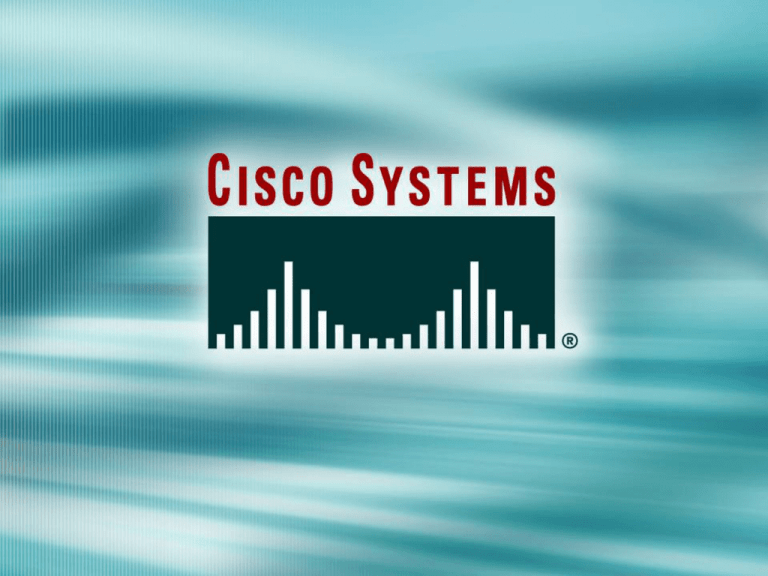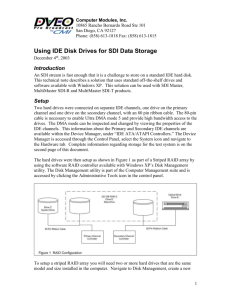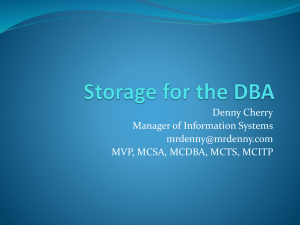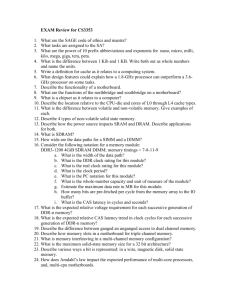
IT Essentials I v. 3
Module 9
Advanced Hardware
Fundamentals for Servers
© 2004, Cisco Systems, Inc. All rights reserved.
2
Module 9
Advanced Hardware Fundamentals for Servers
9.1 – Network Server Overview
9.2 – Hardware Based Raid Configuration
9.3 – Configuring External Peripherals
9.4 – Adding Hardware to a Server
9.5 – Upgrading Server Components
Network Server Overview
Network Server
• A network server is a computer
system in a network that is
shared by multiple users.
• Servers come in all sizes from
x86-based PCs to IBM
mainframes.
• The term "server" may refer to
both the hardware and
software (the entire computer
system) or just the software
that performs the service.
RAID
• Redundant Array of Inexpensive Disks (RAID) is
designed to allow some fault tolerance to prevent
loss of data in the event of a disk drive failure on
a network server.
• Recently, the phrase “redundant array of
independent disks” has become common,
substituting the word “independent” for
inexpensive.
• RAID accomplishes this fault tolerance or
redundancy through disk drives storing parity or
the same information to two different disk drives.
RAID
• RAID 0 is just an array (or
group) of disk drives used as a
single disk. The data is written
in chunks or stripes to all the
disk drives in the array.
• RAID 1 requires a minimum of
two disk drives to implement.
• In disk mirroring, the two disk
drives are connected to the
same disk controller.
• To eliminate this single point of
failure, use disk duplexing
rather than disk mirroring.
RAID
• The problem with disk mirroring is
that if the disk controller fails, there
is no access to the mirrored data.
• RAID 2 uses a hamming code to
create an Error Correcting Code
(ECC) for all data to be stored on
the RAID 2 array.
• RAID 3 uses bit-level parity with a
single parity disk to provide fault
tolerance of data stored on the
RAID 3 array.
• RAID 4 uses block-level parity with
a single parity disk to provide fault
tolerance to the RAID 4 array.
RAID
• RAID 5 uses block-level
parity, but spreads the
parity information among all
the disk drives in the disk
array.
• The loss of storage capacity
in RAID 5 systems is
equivalent to the storage
capacity of one of the disk
drives.
• RAID 0/1 is also known as
RAID 0+1 and it is
sometimes called RAID 10.
RAID Controller
• RAID controllers are
specialized disk controllers
that use either ATA or SCSI
technologies.
• RAID controllers often have
an onboard memory cache
ranging in size from 4 MB to
256 MB.
• The memory cache on the
RAID controller can usually
be configured as read
cache, write cache, or a
combination of both.
Hardware RAID Versus Software RAID
• RAID is usually implemented using a RAID disk
controller and disk controllers are expensive.
• Software RAID is usually implemented at the disk
partition level rather than the physical disk level as in
hardware RAID.
• The drawback to software RAID is that it requires the
network server processor to perform the work usually
done by the RAID controller in hardware RAID.
• Software-based RAID does have one advantage over
hardware-based RAID. In software-based RAID, the
RAID implementation can be based on disk partitions
rather than entire disk drives.
Hardware-Based RAID Configuration
Hardware-Based RAID Configuration
Overview
• Network servers that
contain a RAID controller
must have the RAID system
configured before the
network operating system
can be installed.
• Configuration of the RAID
system consists of selecting
actual physical disk drives
and grouping them together
into one of the available
RAID configurations.
RAID 0 Configuration
• RAID 0 is known as disk
striping.
• It is not fault tolerant, but it is
used to improve disk
input/output performance.
• It is often used in a highpowered workstation to
improve disk input/output
performance by reading and
writing files in blocks to
several disks simultaneously
as opposed to reading and
writing a file sequentially to a
single disk drive.
RAID 1 Configuration
• RAID 1 has two different
implementations: disk
mirroring and disk
duplexing.
• In disk mirroring, everything
written to one disk is also
written to a second disk.
• Disk duplexing eliminates
the single point of failure
that exists in disk mirroring.
RAID 5 Configuration
• RAID 5 requires a minimum
of three disk drives to
implement.
• The disk drives that
comprise a RAID 5 solution
are often referred to as a
RAID 5 array.
• RAID 5 is more efficient
than the other RAID levels
in that the overhead is 1/n *
100, where n is the number
of disk drives in the RAID 5
array.
RAID 0/1 Configuration
• RAID 0/1 (sometimes called
RAID 0+1 or RAID 10)
involves mirroring (or
duplexing) two RAID 0
arrays.
• This yields the fault
tolerance of RAID 1 and the
input/output speed of RAID
0.
• RAID 0/1 requires a
minimum of four disk drives
to implement.
Configuring External Peripherals
Overview of External Disk Subs
• External disk subsystems are necessary when the
amount of disk storage cannot be accommodated by
the disk drive bays internal to the network server
chassis.
• These external disk subsystems can be either SCSI
or Fibre Channel.
• Generally, Fibre Channel–based systems can
support many more disk drives than a SCSI-based
external system.
Configuring an External Disk Subsystem
• External disk subsystems may consist of a single disk
drive in its own chassis with its own power supply. On
the high end, an external disk subsystem chassis
might have 100 or more disk drives in it.
• The simple external disk subsystem with only a few
disk drives might just be attached to the external port
on a SCSI or RAID controller.
• Some large external disk subsystems may have their
own RAID mechanism built right in. These large
systems are often configured separately from the disk
controller in the network server to which they will be
attached.
Configuring an External CD-ROM System
• External CD-ROM systems are often referred to as a
CD-ROM library.
• Imagine a tower chassis with 7, 14, 21, or more CDROM drives.
• Having these CD-ROM drives attached to a network
server means that it is possible to share all these CDROM drives and the CD-ROMs that they contain with
all users on the network.
Adding Hardware to a Server
Replacing a Single Processor
with a Faster Processor
• The user has to determine whether a faster
processor is available in a form factor that is
compatible with the existing processor.
• Upgrading to a faster processor may also require
upgrading the BIOS on the system board.
• Cover the seven steps needed to perform a single
processor upgrade.
Installing Additional Processors
• To add another processor to a
multiprocessor-capable network
server, the new processor must
meet the following criteria:
– Be the same model processor as
the existing processor
– Have the same clock speed
– Have the same Level 2 (L2)
cache size
– Match the stepping within one
version (N+1)
• Here are sample outputs from
the Windows and bootable floppy
version of the Intel identification
program.
Upgrading the Operating System
for Multiple Processors
• If the original installation of Microsoft Windows NT Server
4 or Windows 2000 Server was on a network server with
a single processor, the hardware abstraction layer (HAL)
on the network server must be updated for the network
server to recognize and use multiple processors.
• If the original installation of Novell NetWare 5 was on a
network server with a single processor, several changes in
the configuration of the Novell NetWare 5 server must be
made for it to recognize and use multiple processors.
• For Red Hat Linux (and other versions of Linux) to
recognize multiple processors, the Linux kernel must be
rebuilt.
Adding Hard Drives
• Disk drive upgrades come in two varieties: adding
disk drives to an existing network server, or replacing
existing disk drives with larger or faster disk drives.
• Before attempting any disk drive upgrade, make
absolutely sure that there is at least one, preferably
two, verified full backups of the data on the disk
drives.
Adding Memory
• Before adding memory to a
network server, verify the current
memory configuration.
• Determine whether the network
server hardware can support
the amount of memory
desired in the network
server.
• Memory modules may have
a requirement to be installed
in pairs or groups of four.
• Most network servers have
SIMMs, DIMMs, or RIMMs.
Upgrading Server Components
Upgrading Adapter Memory
• Adapter upgrades also fall into several categories:
upgrading components on the adapter, such a
memory; upgrading the BIOS or firmware on the
adapter; and replacing the adapter with a newer,
faster, or more powerful adapter.
• The following adapters use onboard memory:
– Video adapter onboard memory
– SCSI adapter onboard memory
– RAID controller onboard memory
Upgrading Adapter BIOS or Firmware
•
Upgrading the BIOS or firmware on an adapter is
similar to upgrading the system BIOS.
•
The steps are vendor specific:
1.
2.
Locate the latest BIOS or firmware on the adapter
vendor’s website
Download the BIOS or firmware upgrade and follow
the vendor’s instructions to install the upgrade
Replacing an Adapter
•
Adapters are generally replaced after they fail. The
replacement procedure generally follows several
simple steps:
1.
2.
3.
4.
•
Power down the network server
Remove the defective adapter
Install the new adapter
Power up the network server
PCI hot plug (or PCI hot swap) enables the user to
replace, upgrade, or add an adapter without
powering down the network server. It has three
capabilities:
1. Hot replacement
2. Hot upgrade
3. Hot expansion
Upgrading Peripheral Devices
• Peripheral devices can be either internal to the server
chassis or external to the network server chassis.
• If the adapters are not plug-and-play, the user may
have to configure the adapters with an interrupt
request (IRQ), a direct memory access (DMA)
channel, and input/output (I/O) address.
• External devices might be hot plug and plug-and-play
compatible. Other external devices might require that
the network server be shut down before they can be
upgraded.
Upgrading System Monitoring Agents
• System monitoring agents
are software specific to the
network server itself.
• System monitoring agents
monitor various aspects of
the network server.
• The agents usually use
standard protocols such as
HTTP, SNMP, and DMI to
report information to a
management console.
Upgrading Service Tools
• Upgrading service tools is generally a software
upgrade operation.
• These updated tools are generally available on either
CD-ROMs supplied by the network server vendor or
from the vendor’s website.
• Most service tools fall into the following general
categories:
– Diagnostic Tools
– EISA Configuration Utility
– Diagnostic Partition Utility
– Server Support Utilities
Document the Configuration
• The reason good documentation is needed is so that
if a problem occurs more than once the user can look
up how to fix it and save himself/herself from doing
the same failed method twice.
• This will in turn save the time fixing it and the user will
be able to have the server back online much faster.








